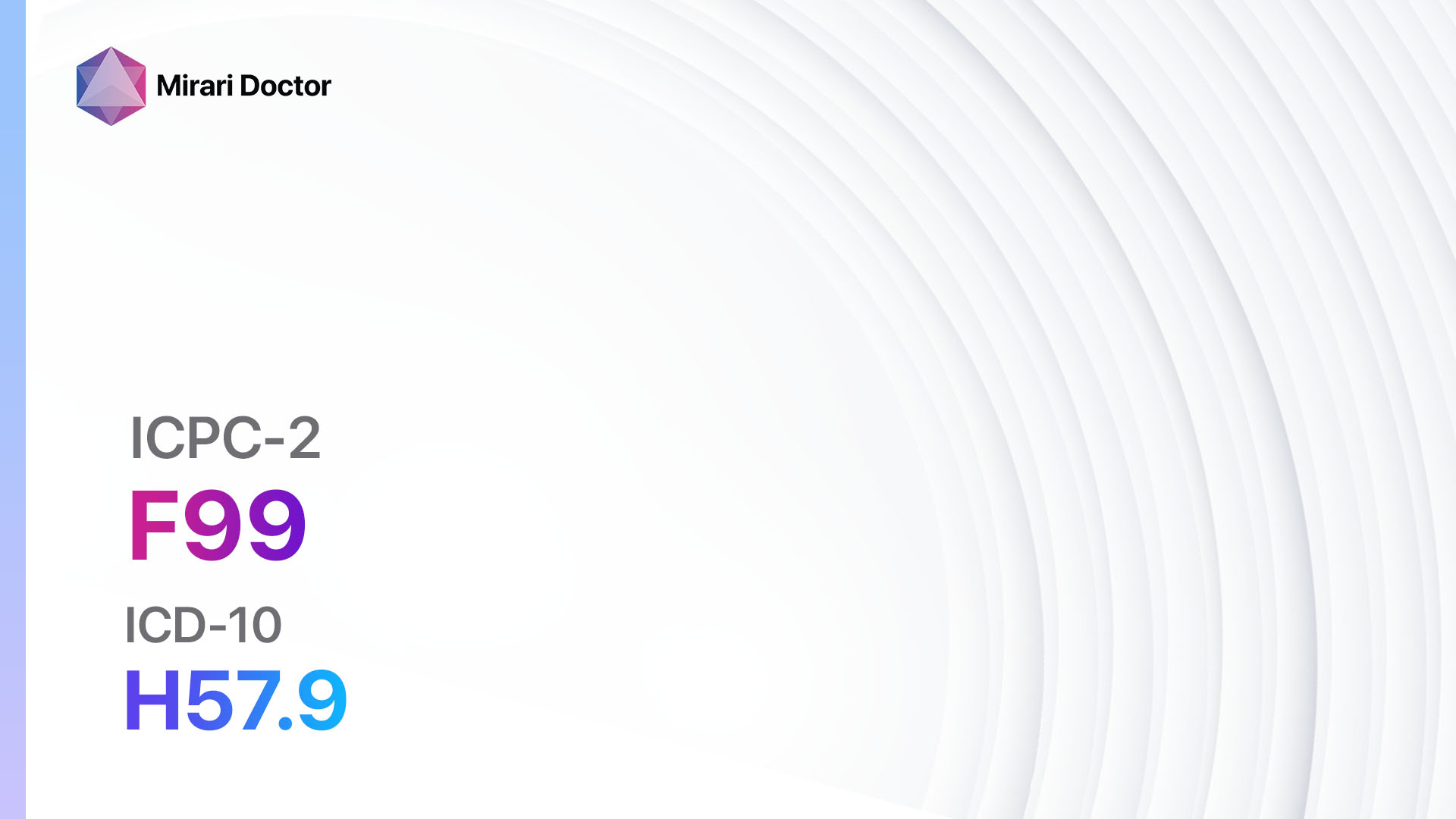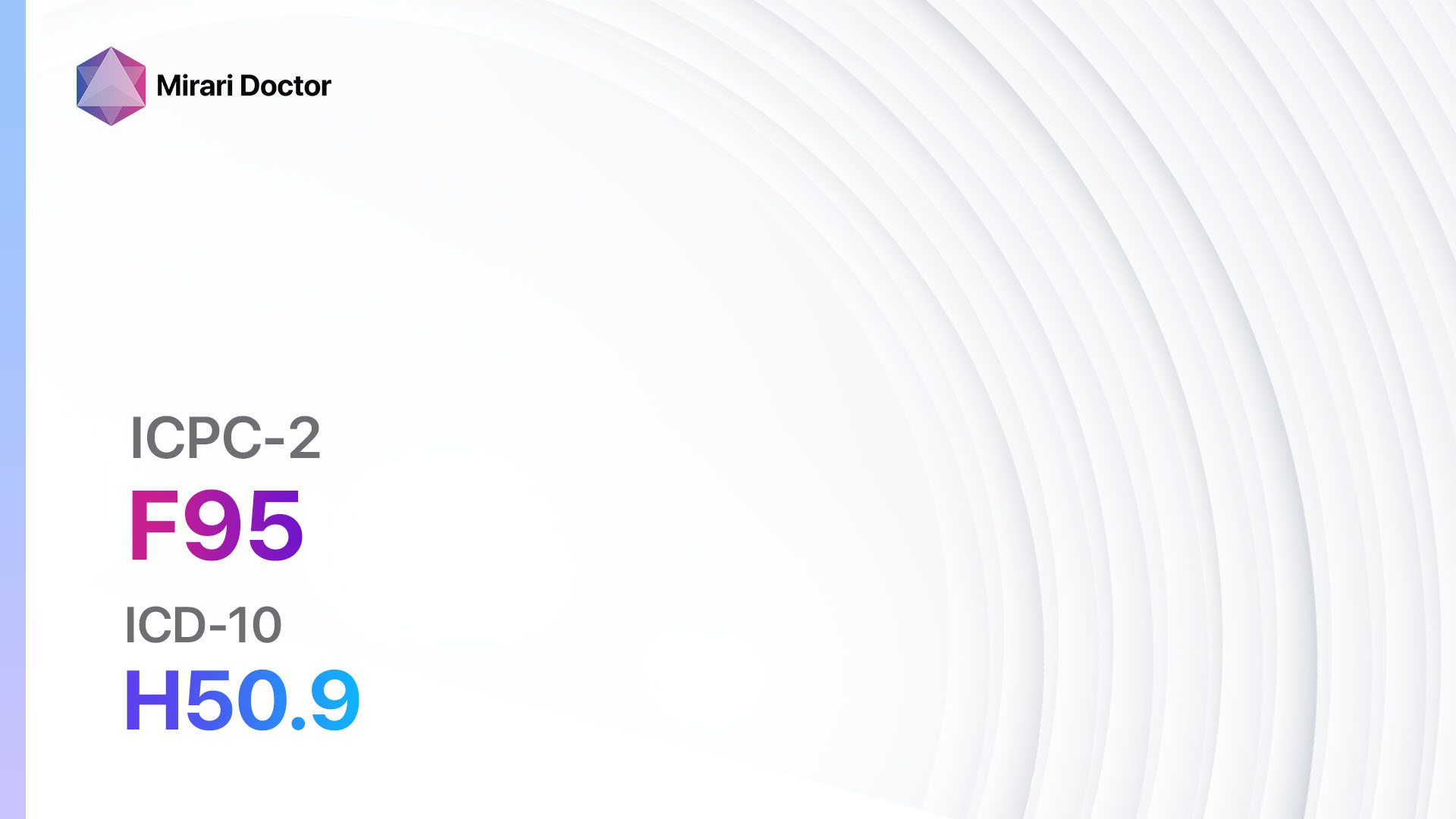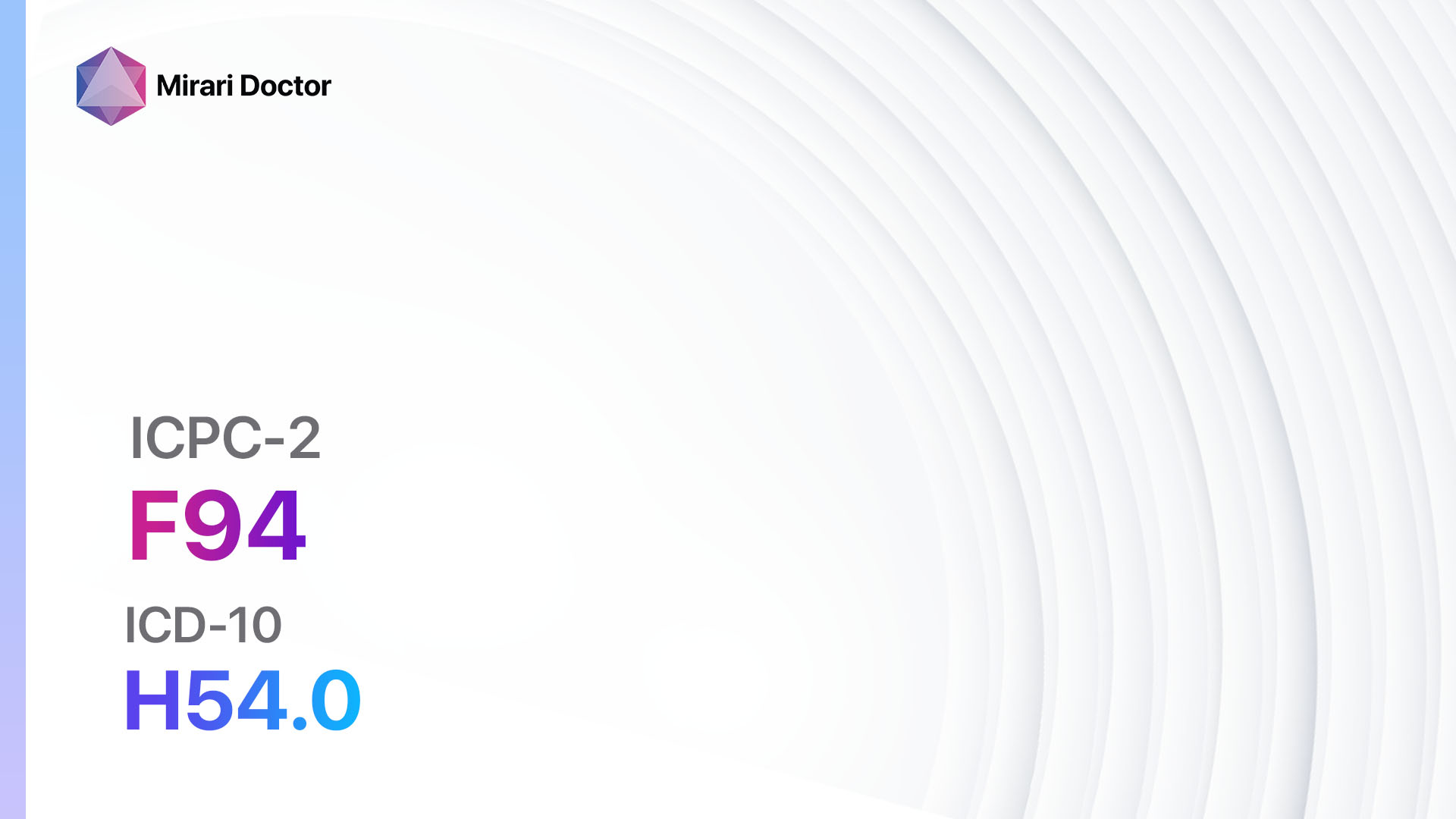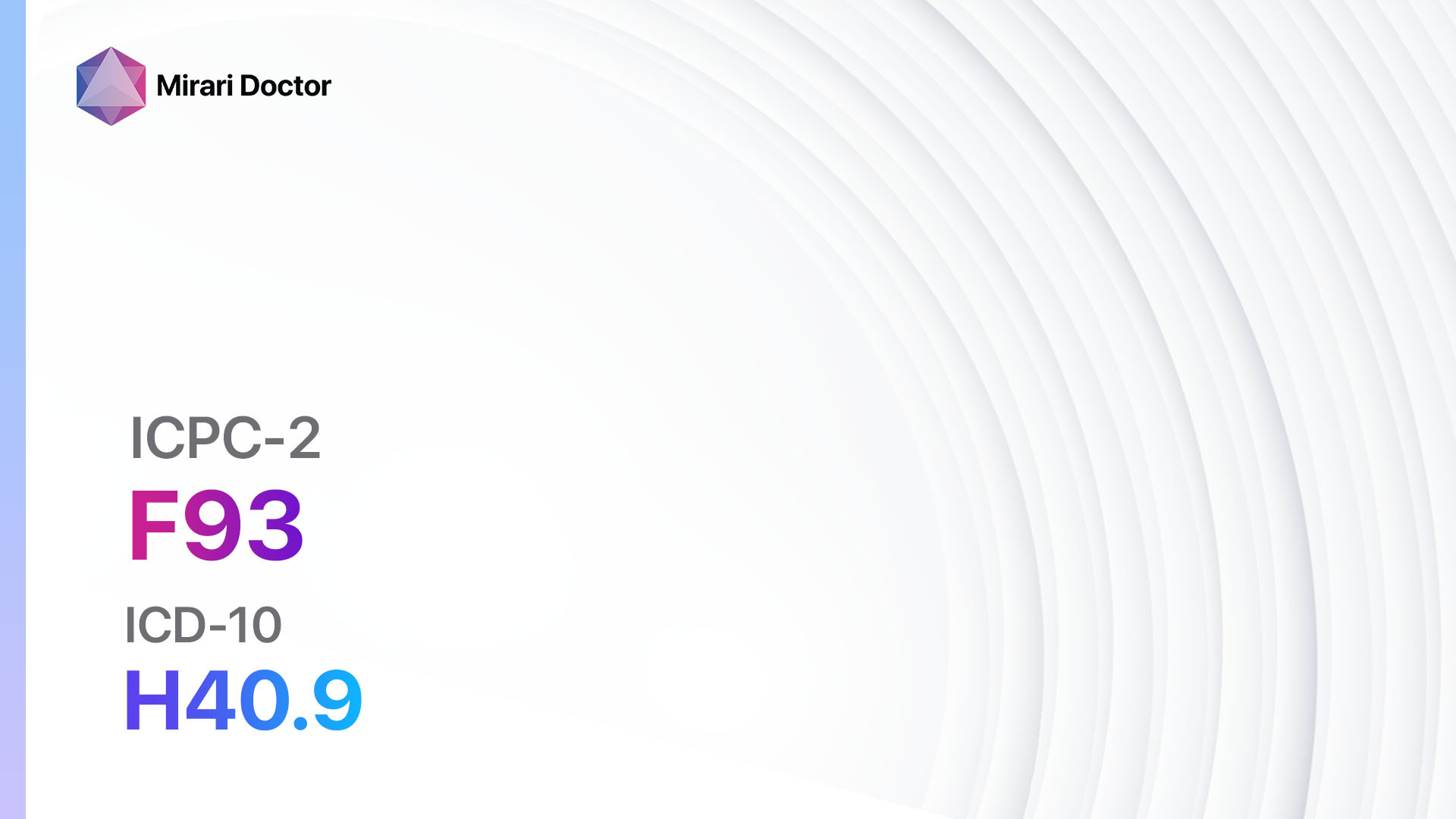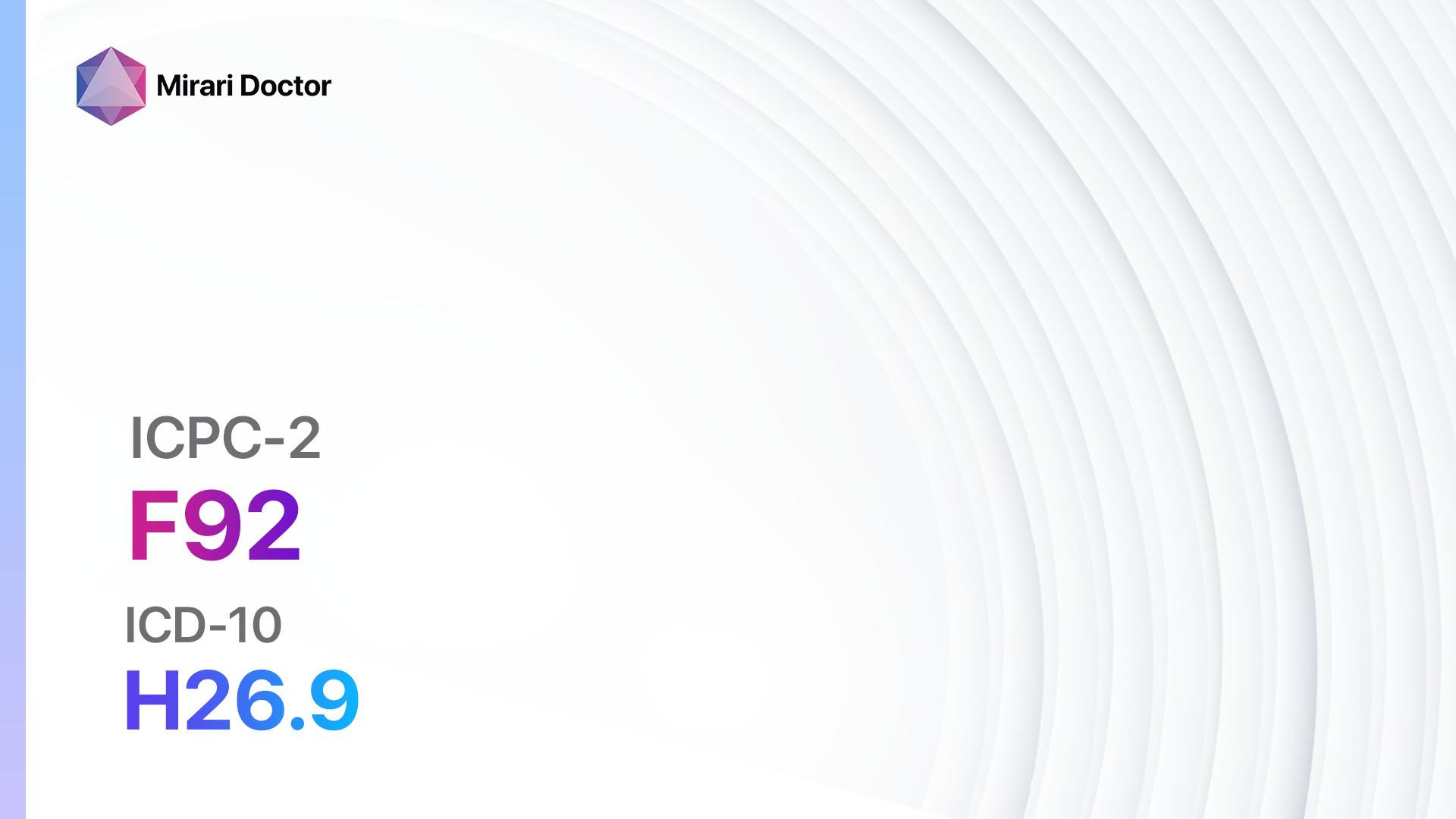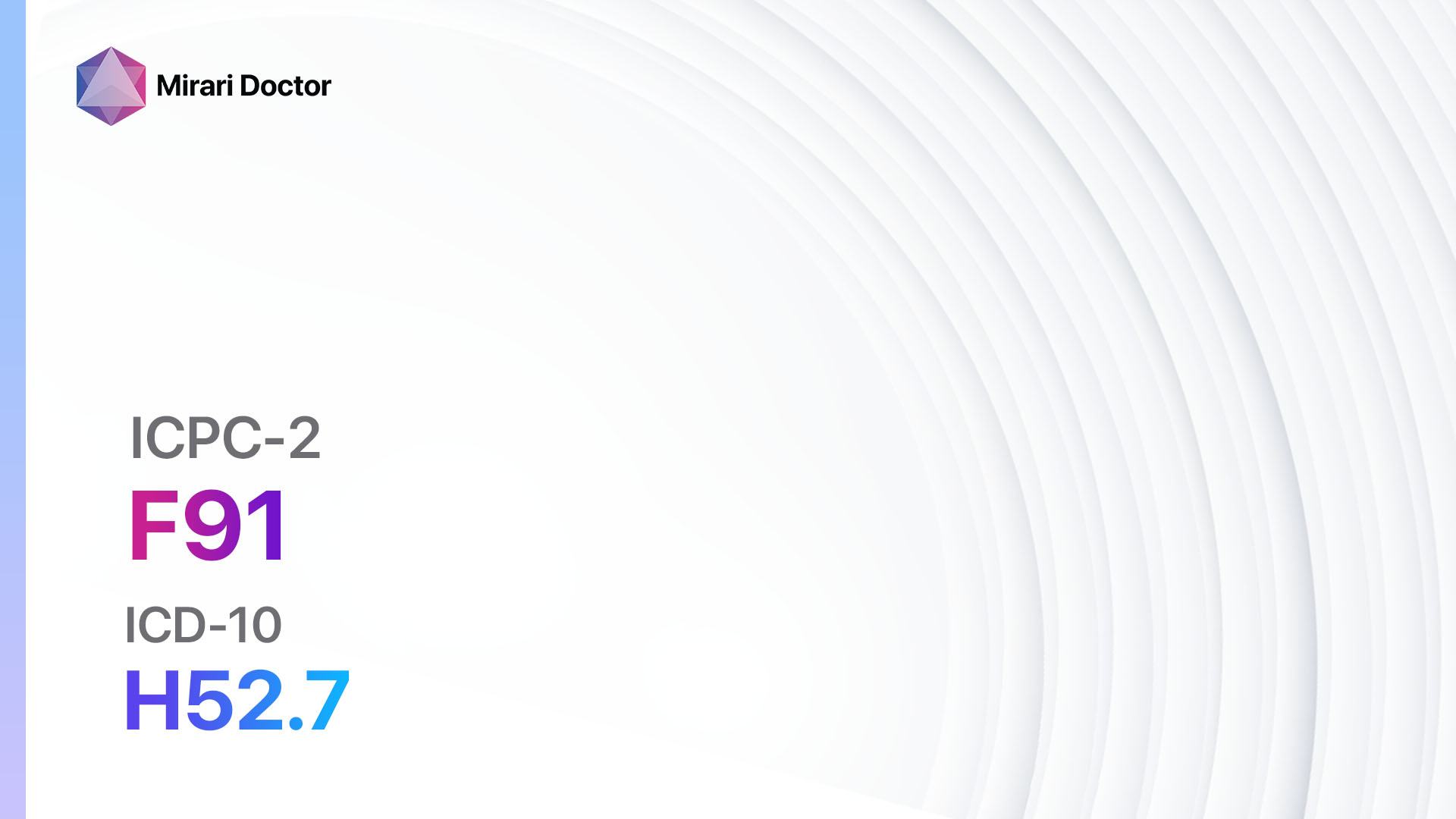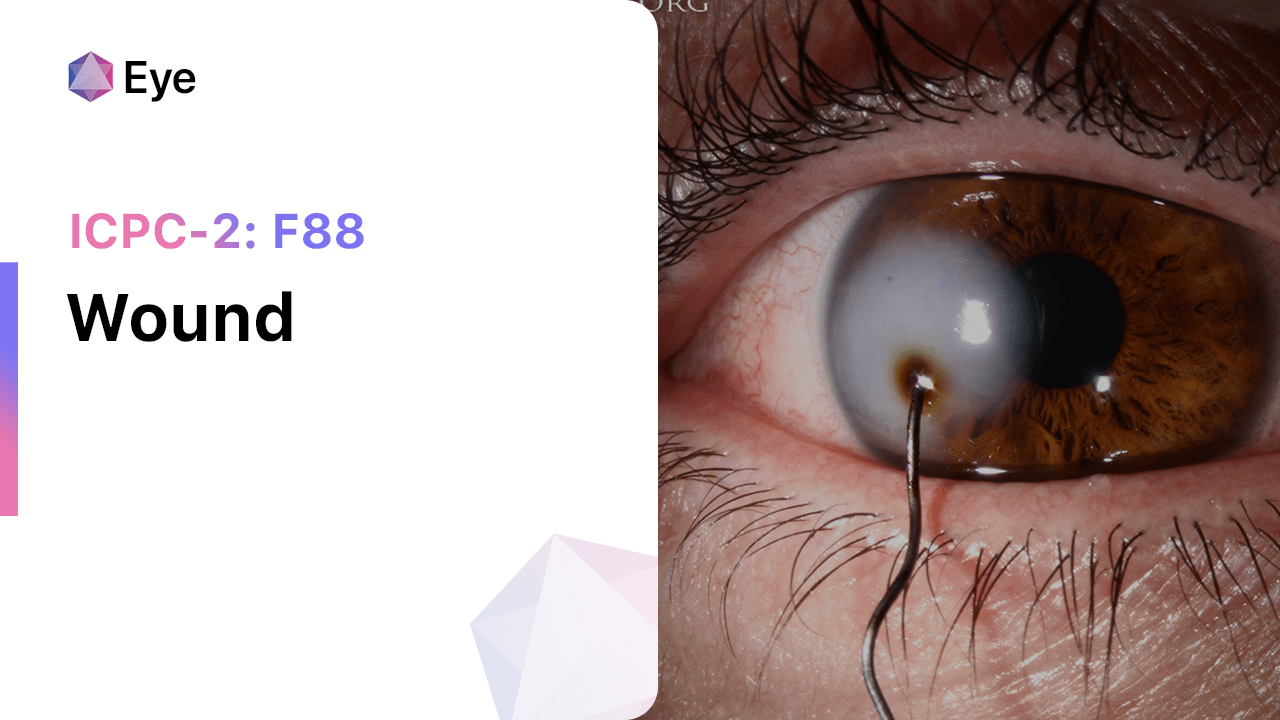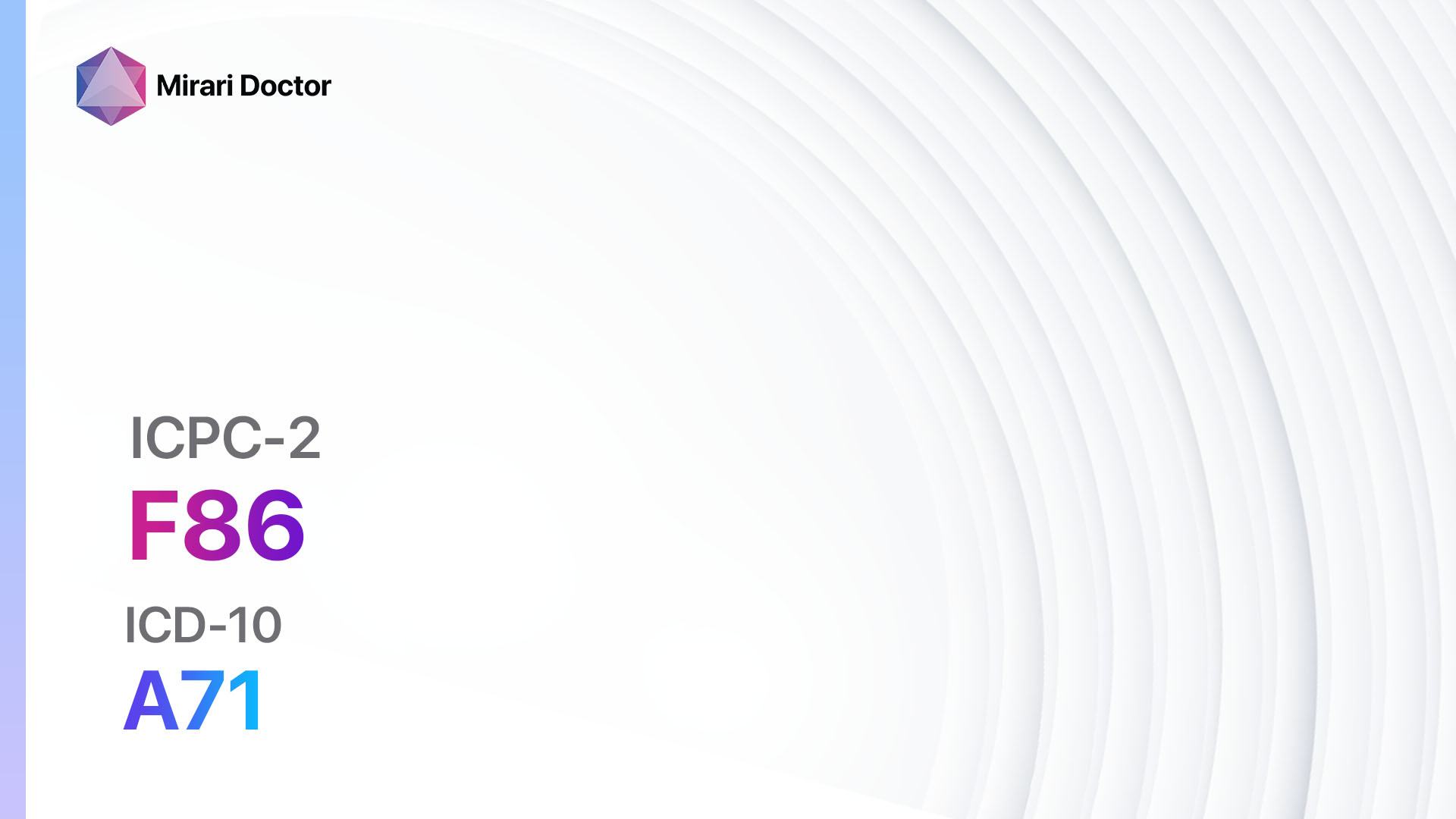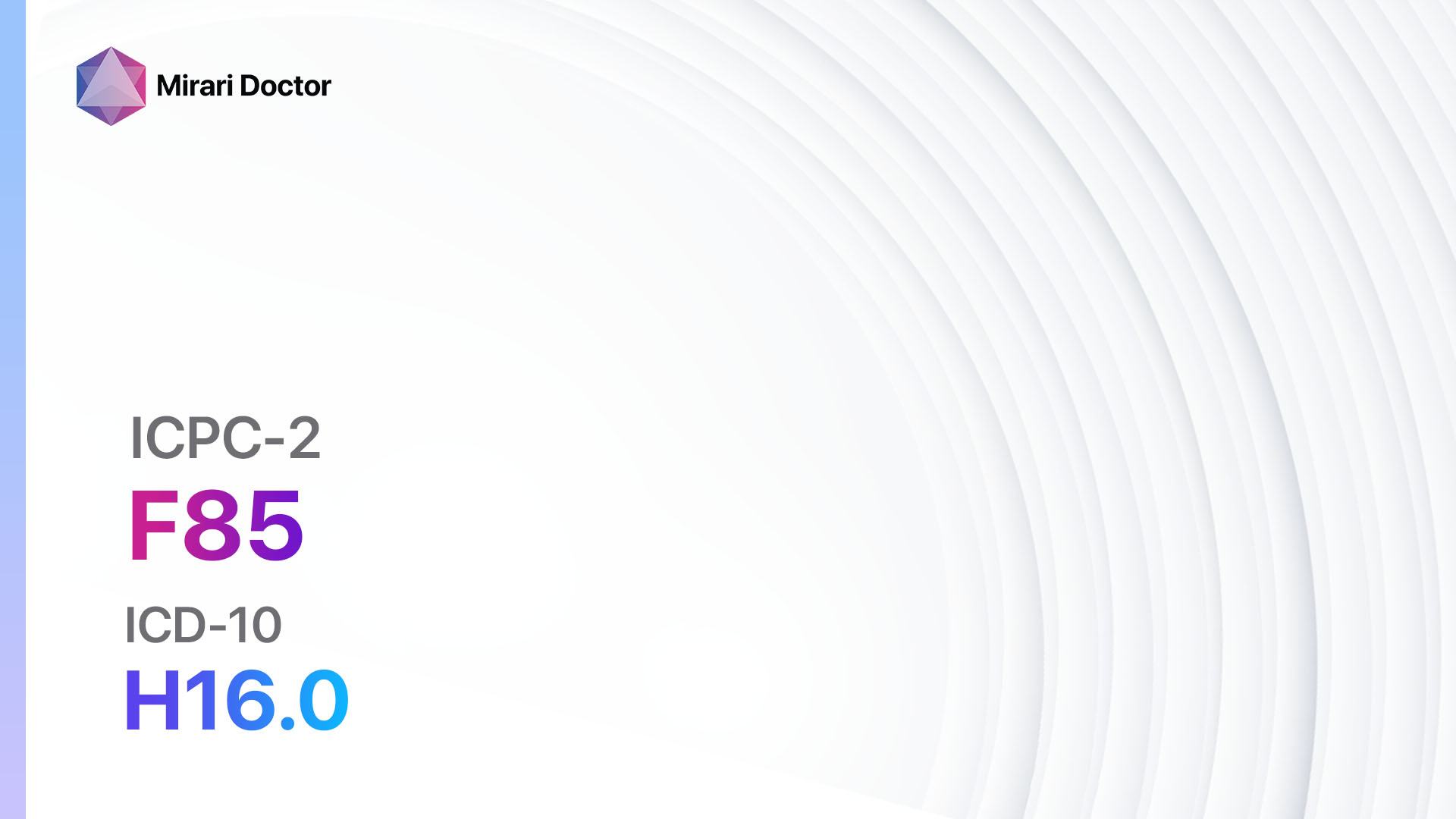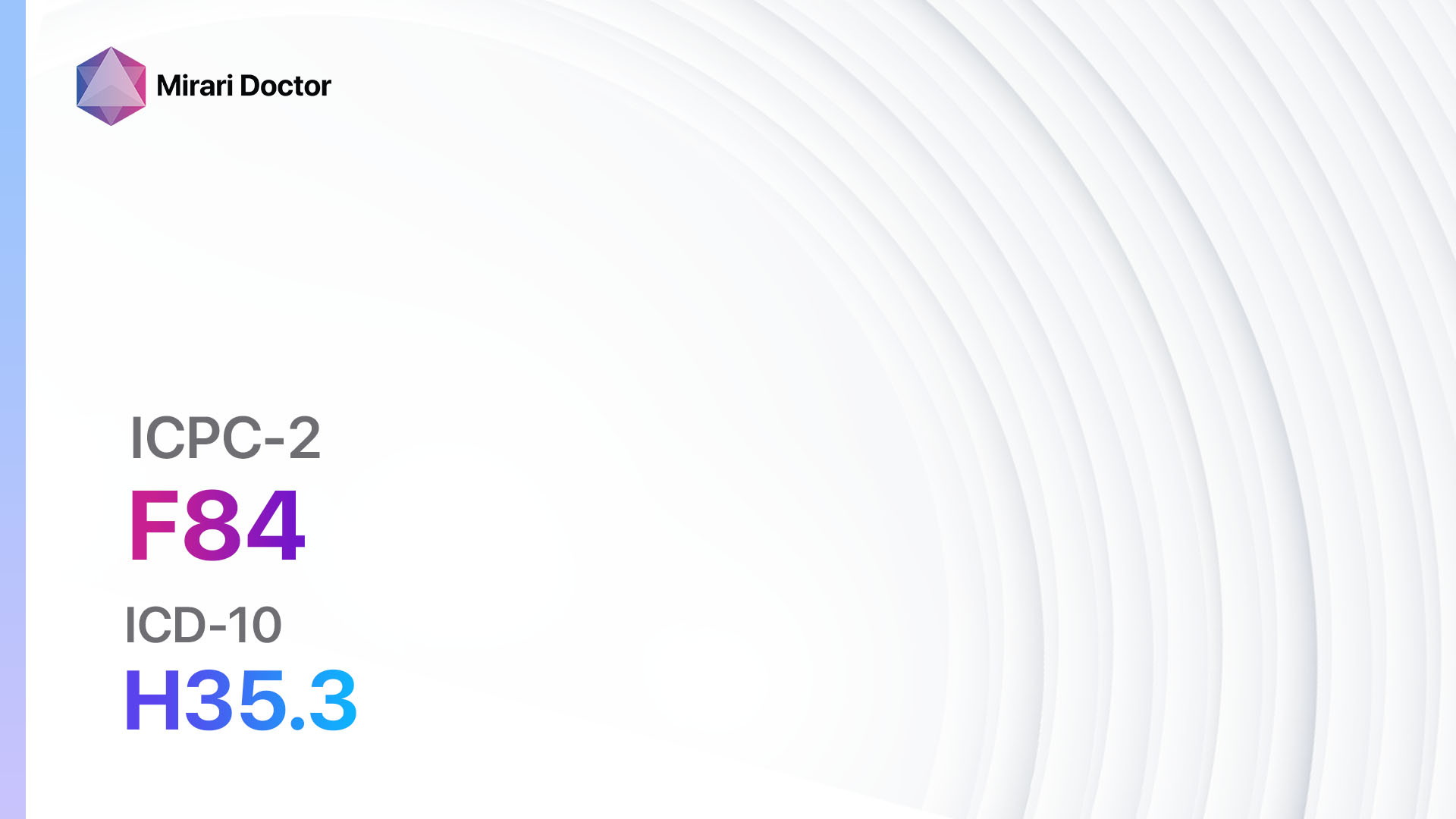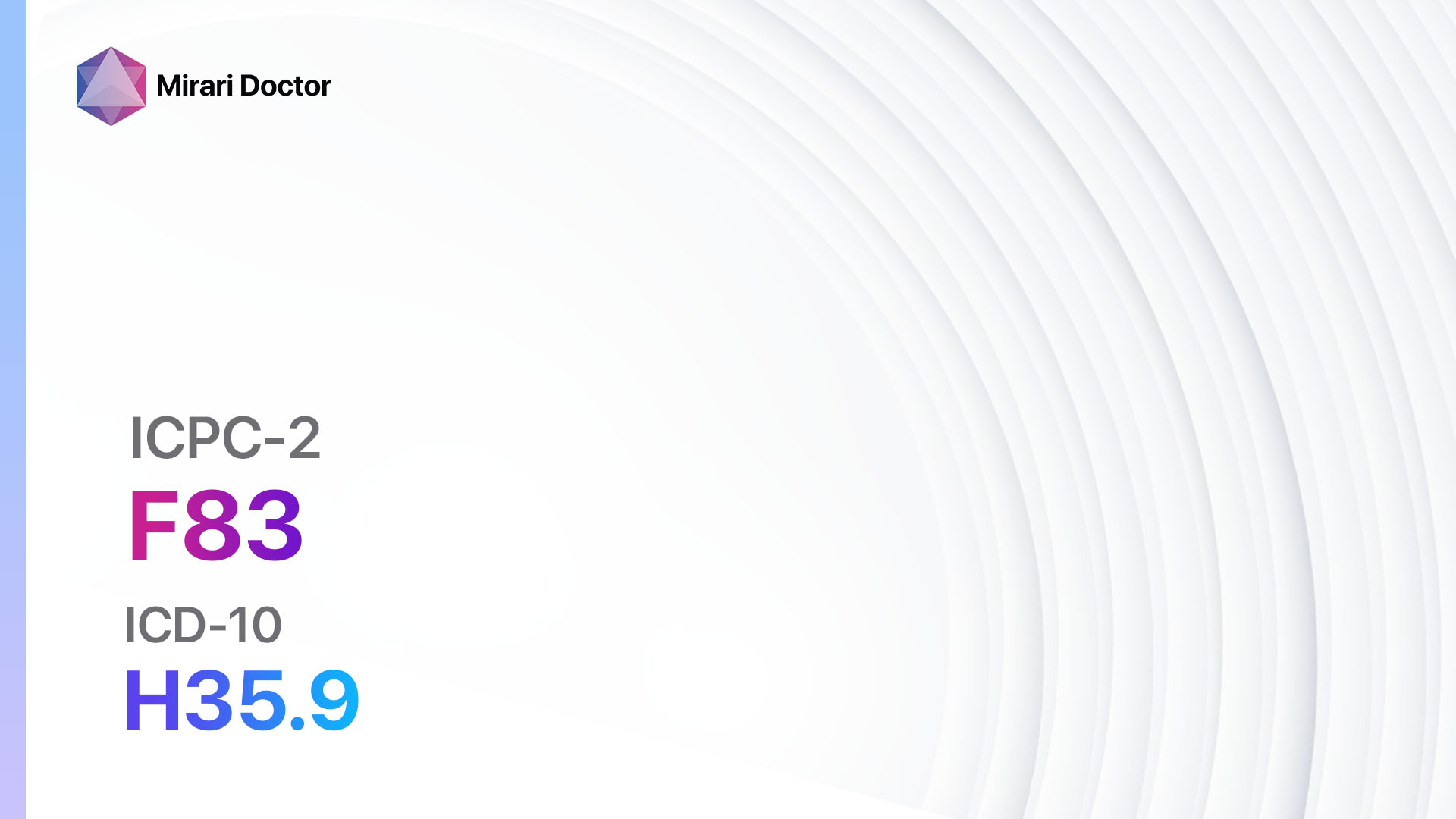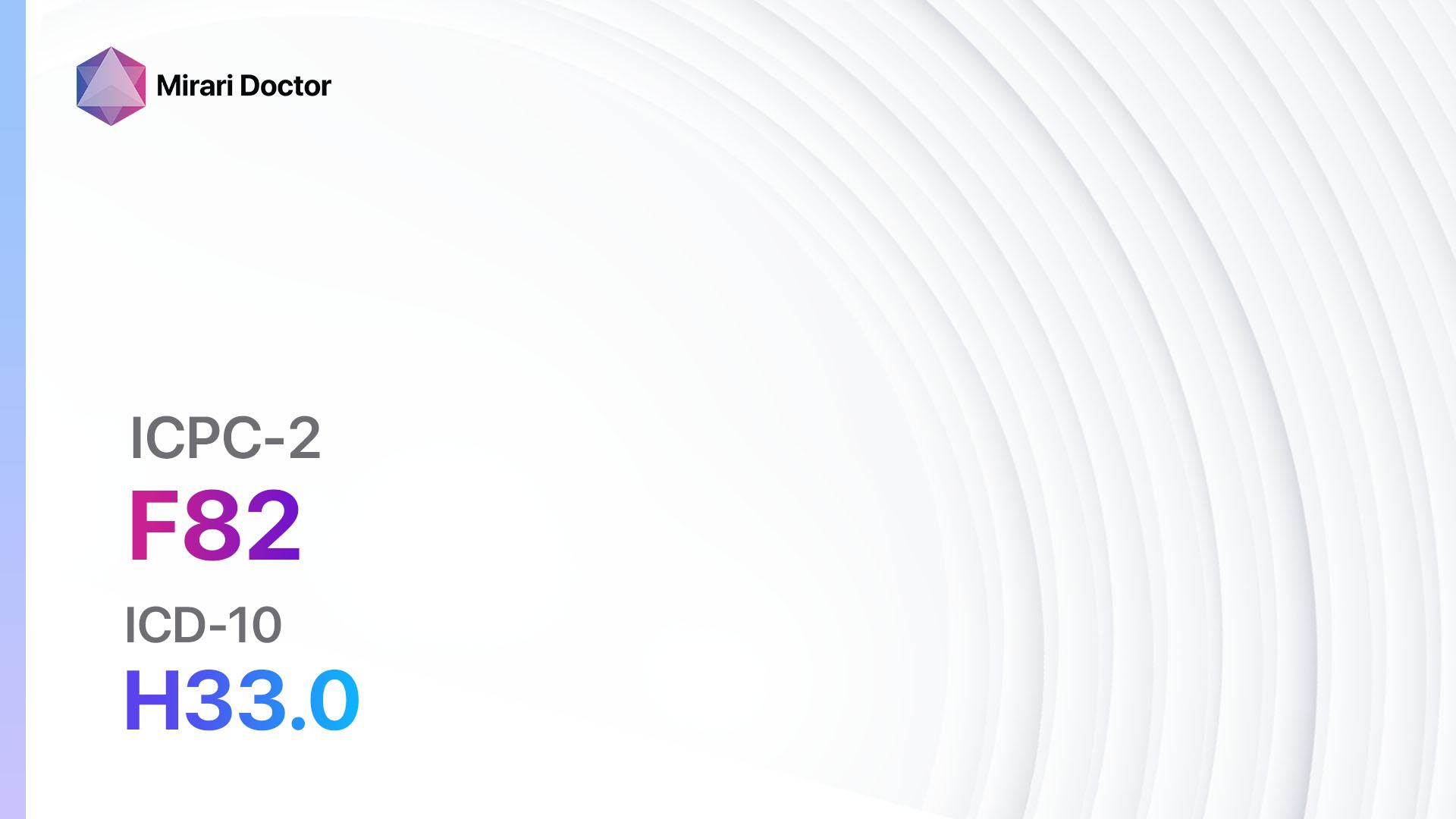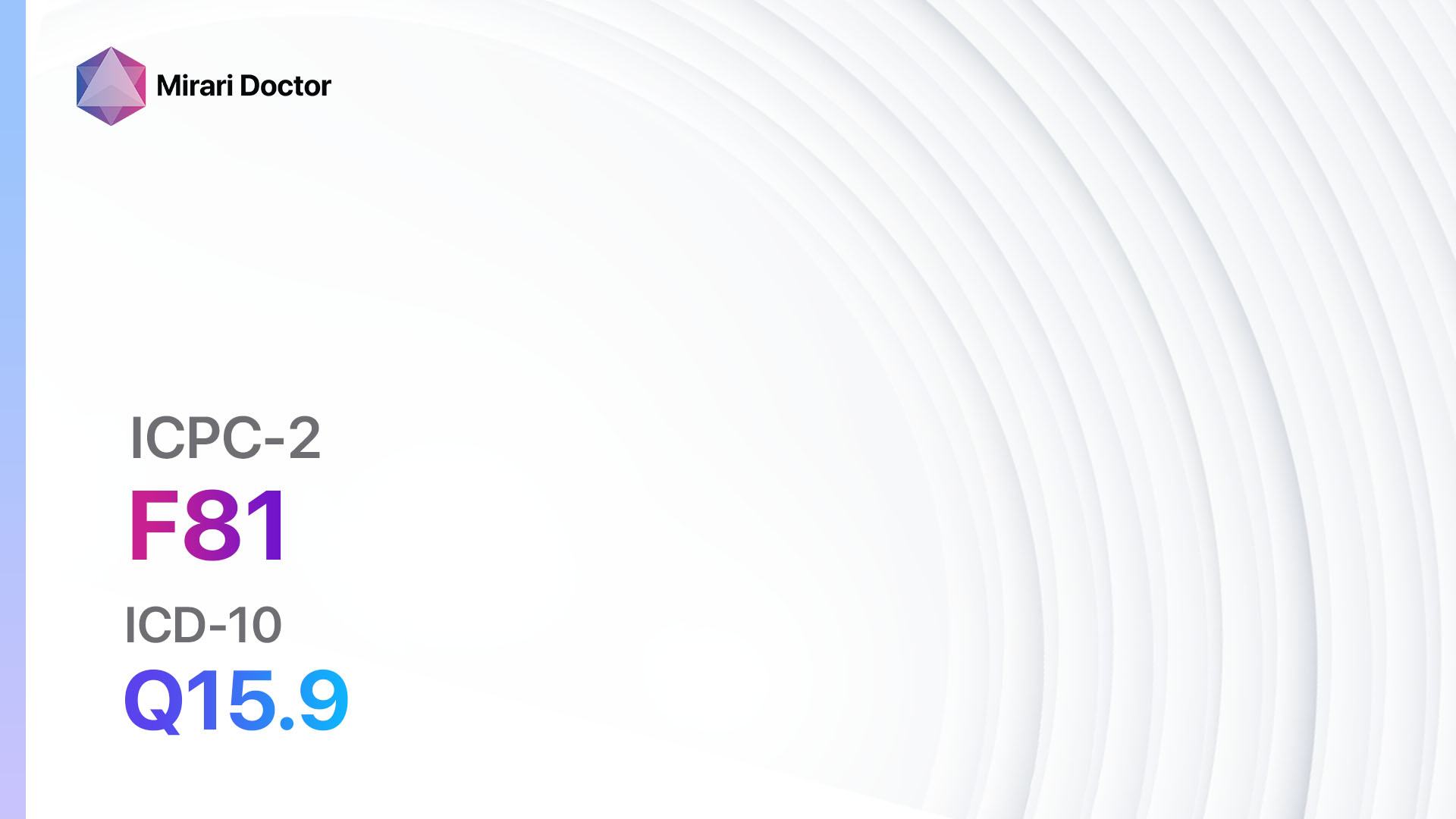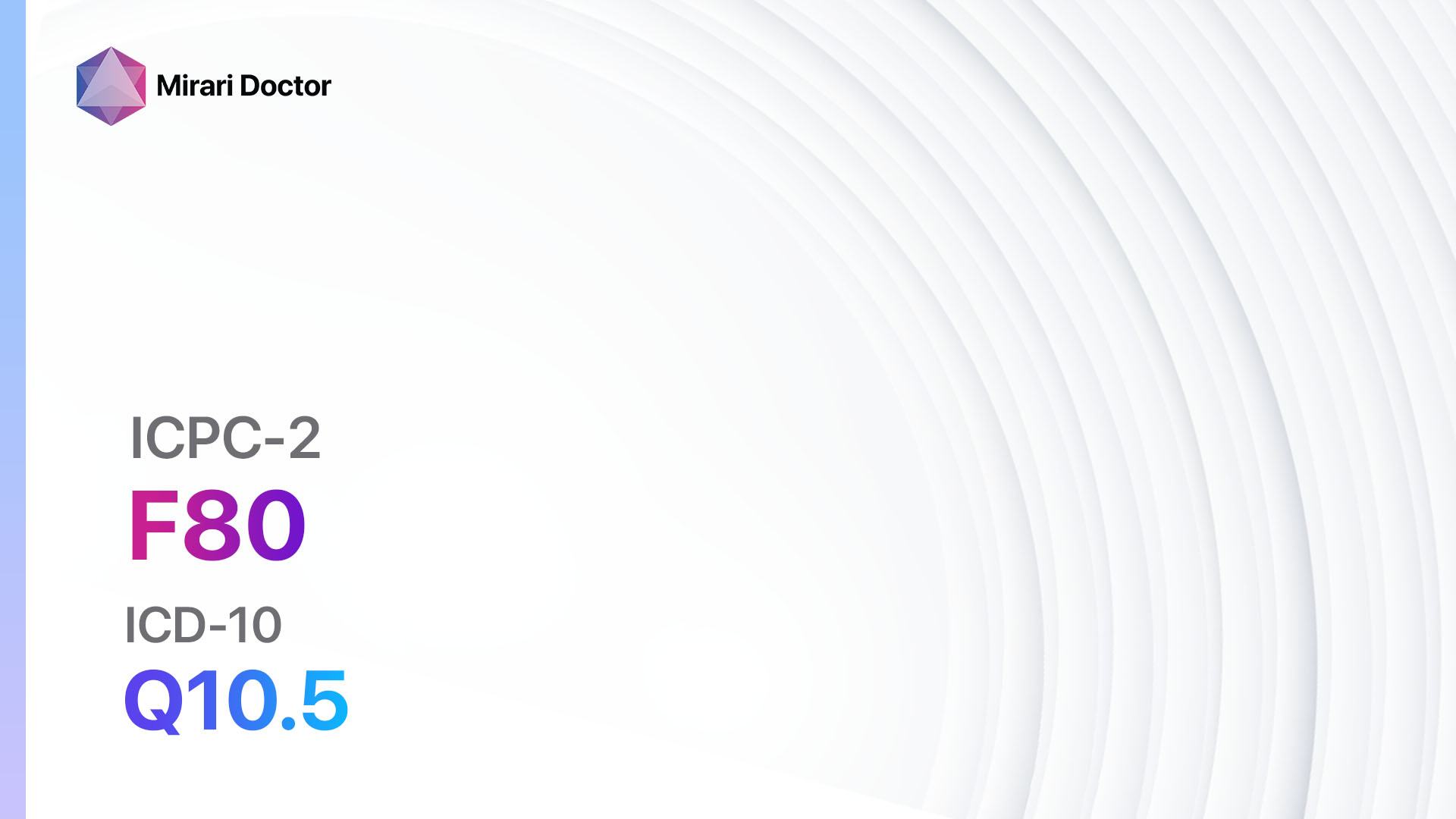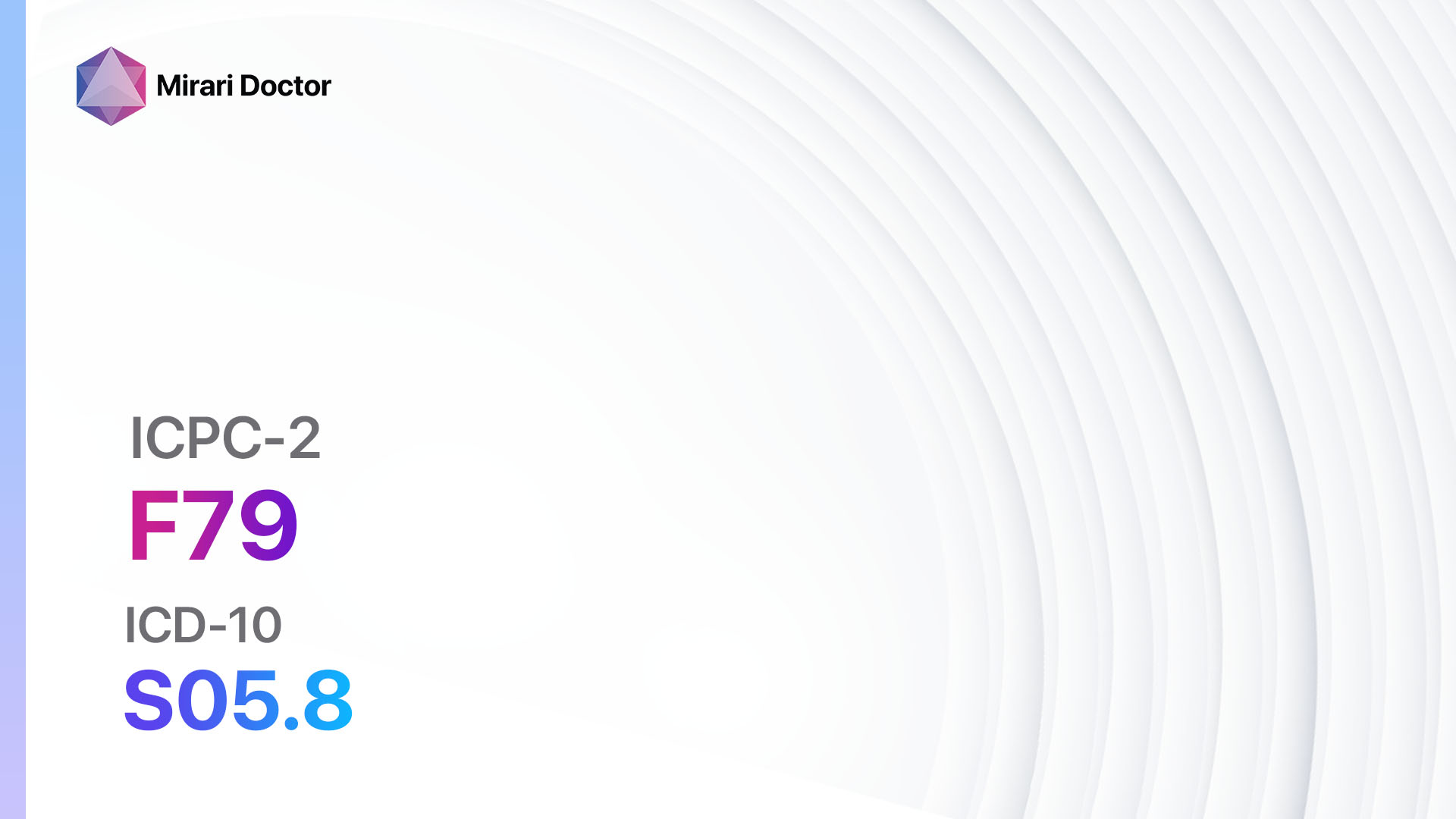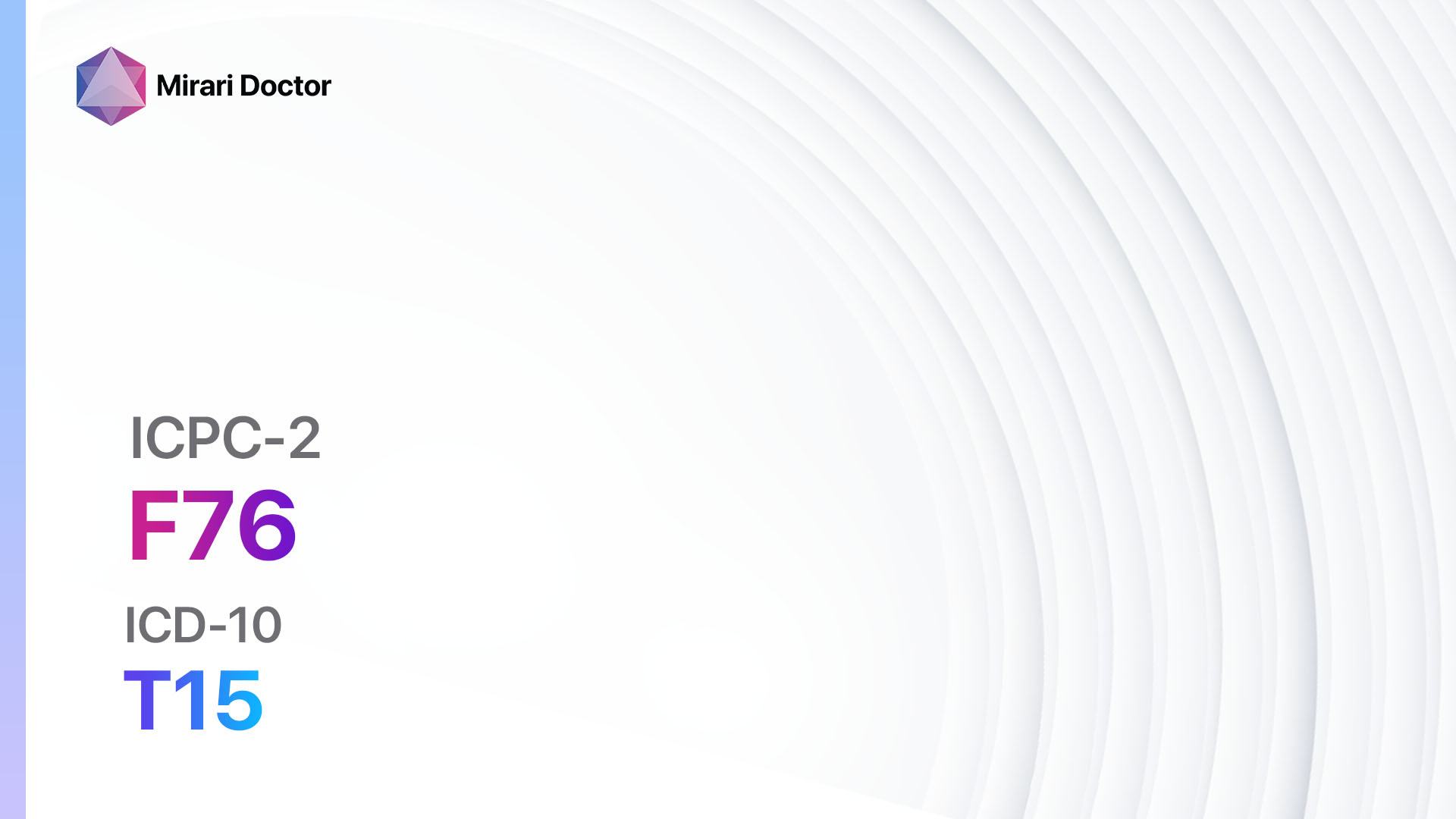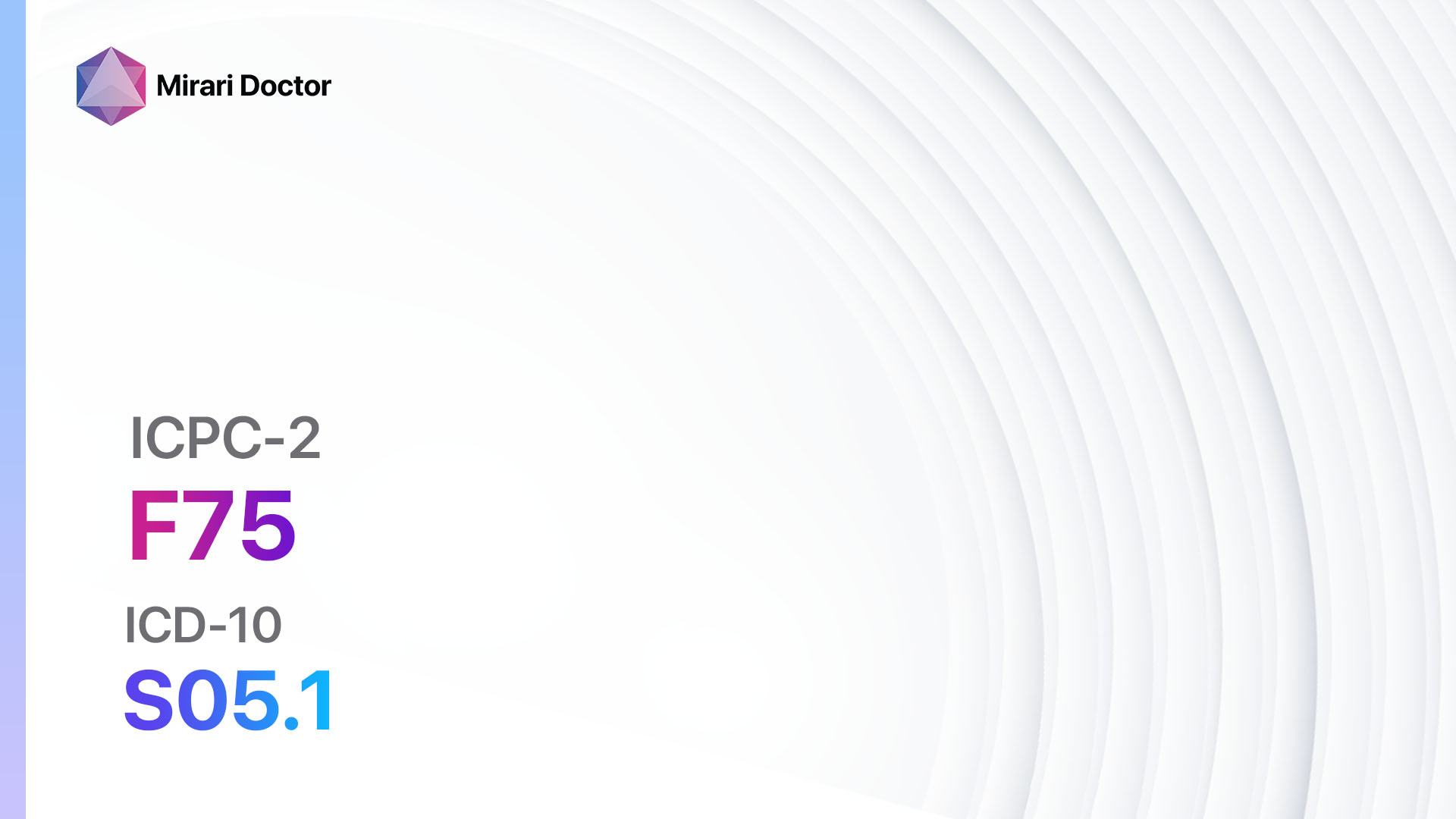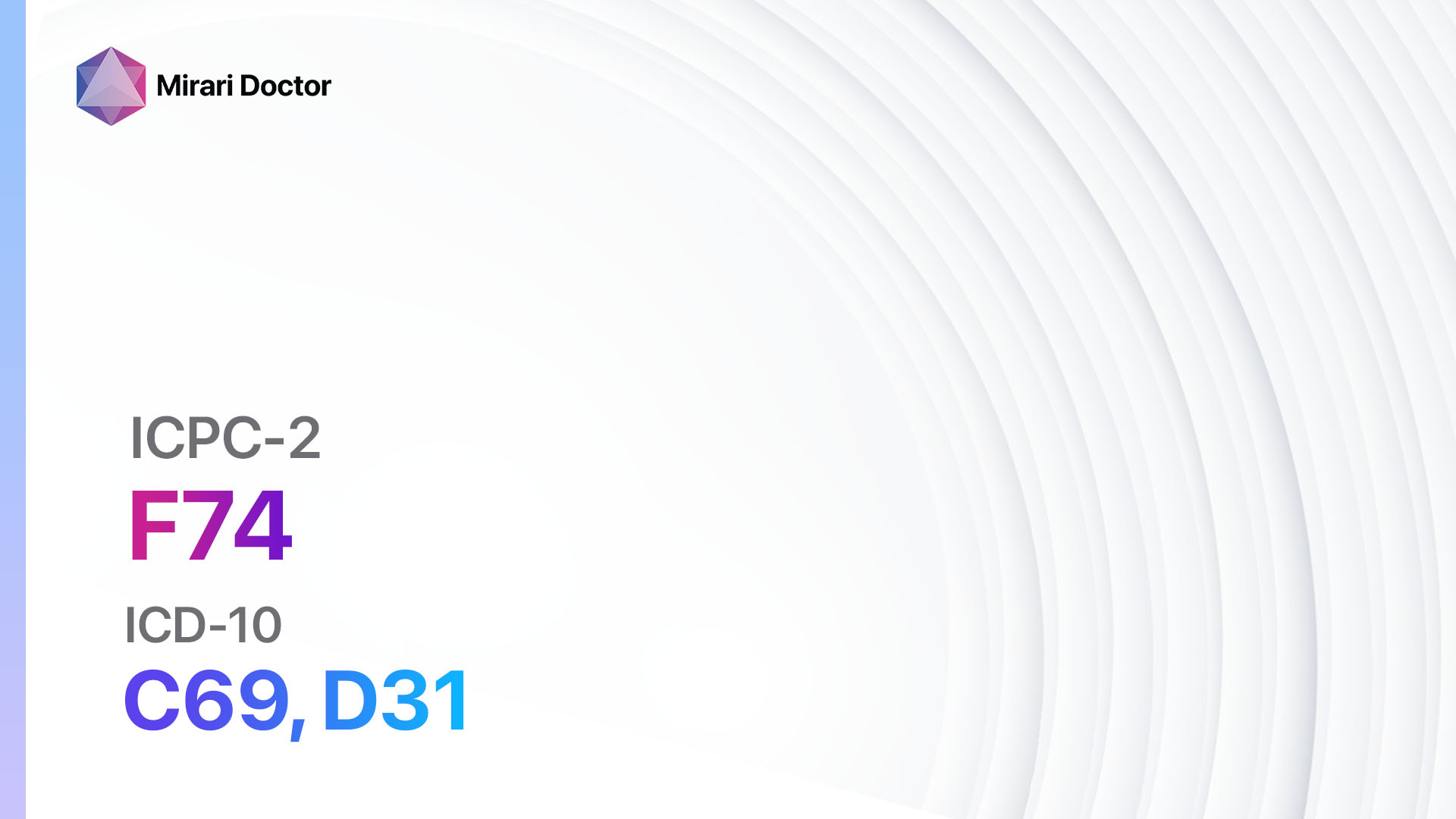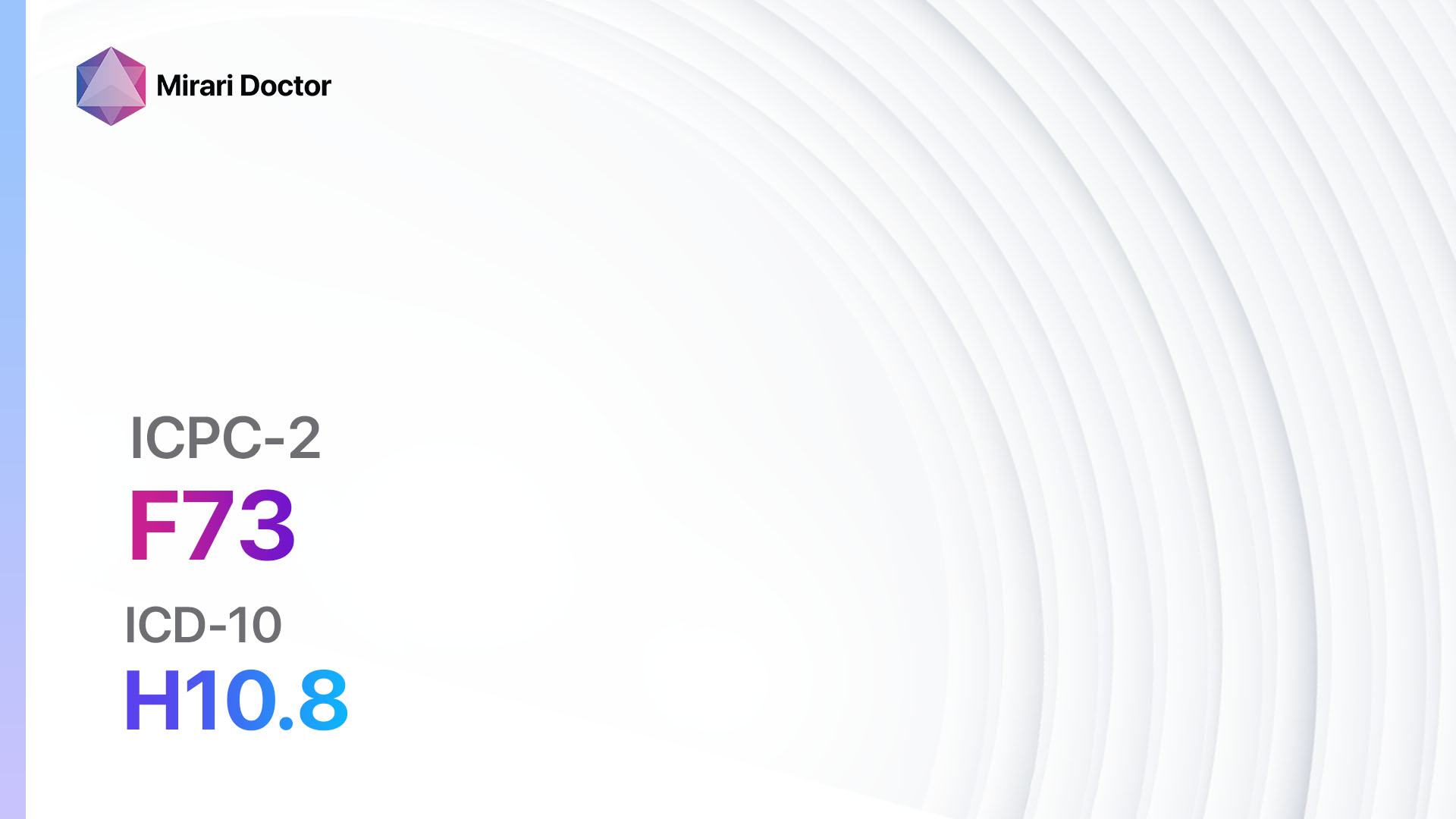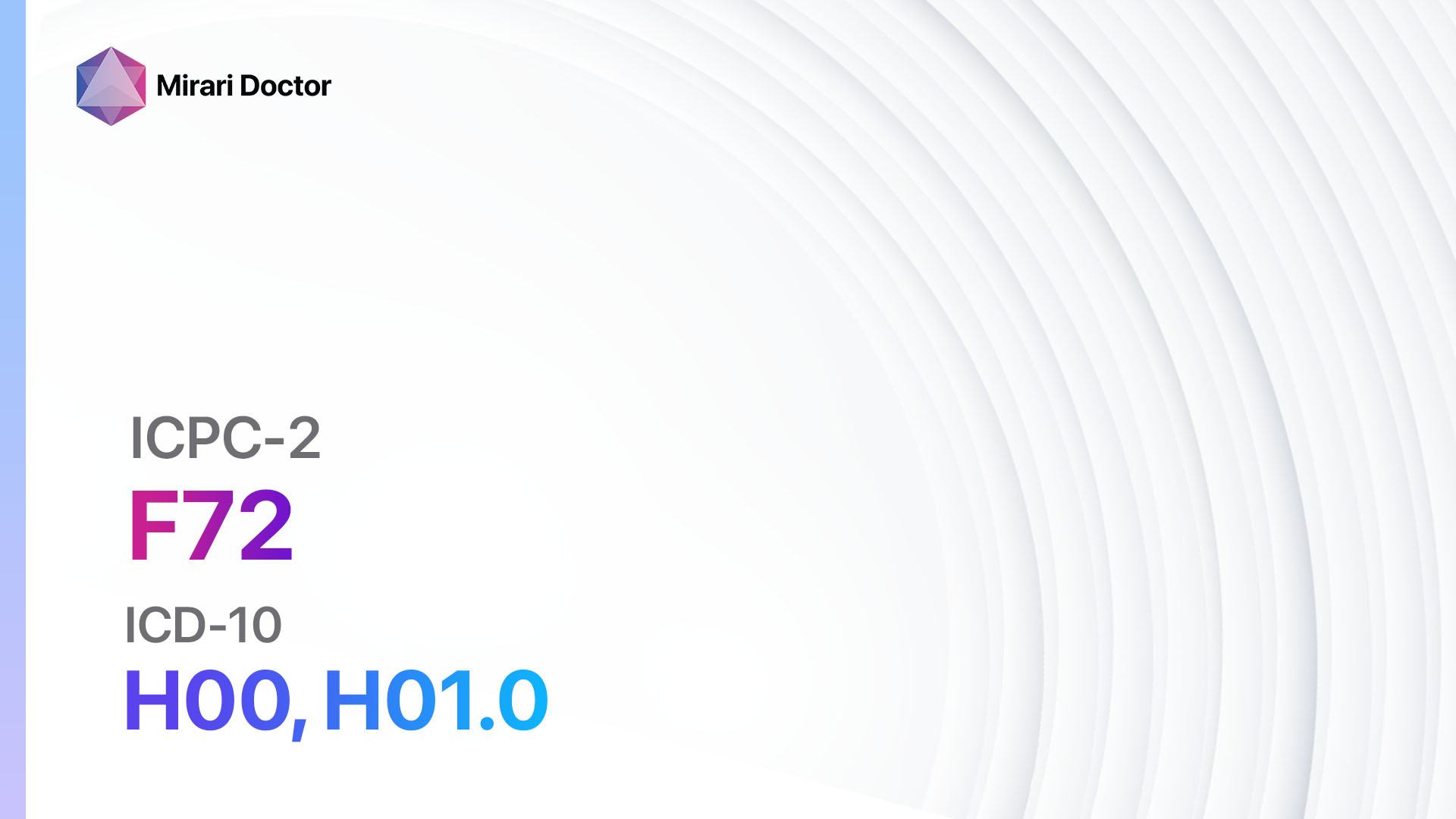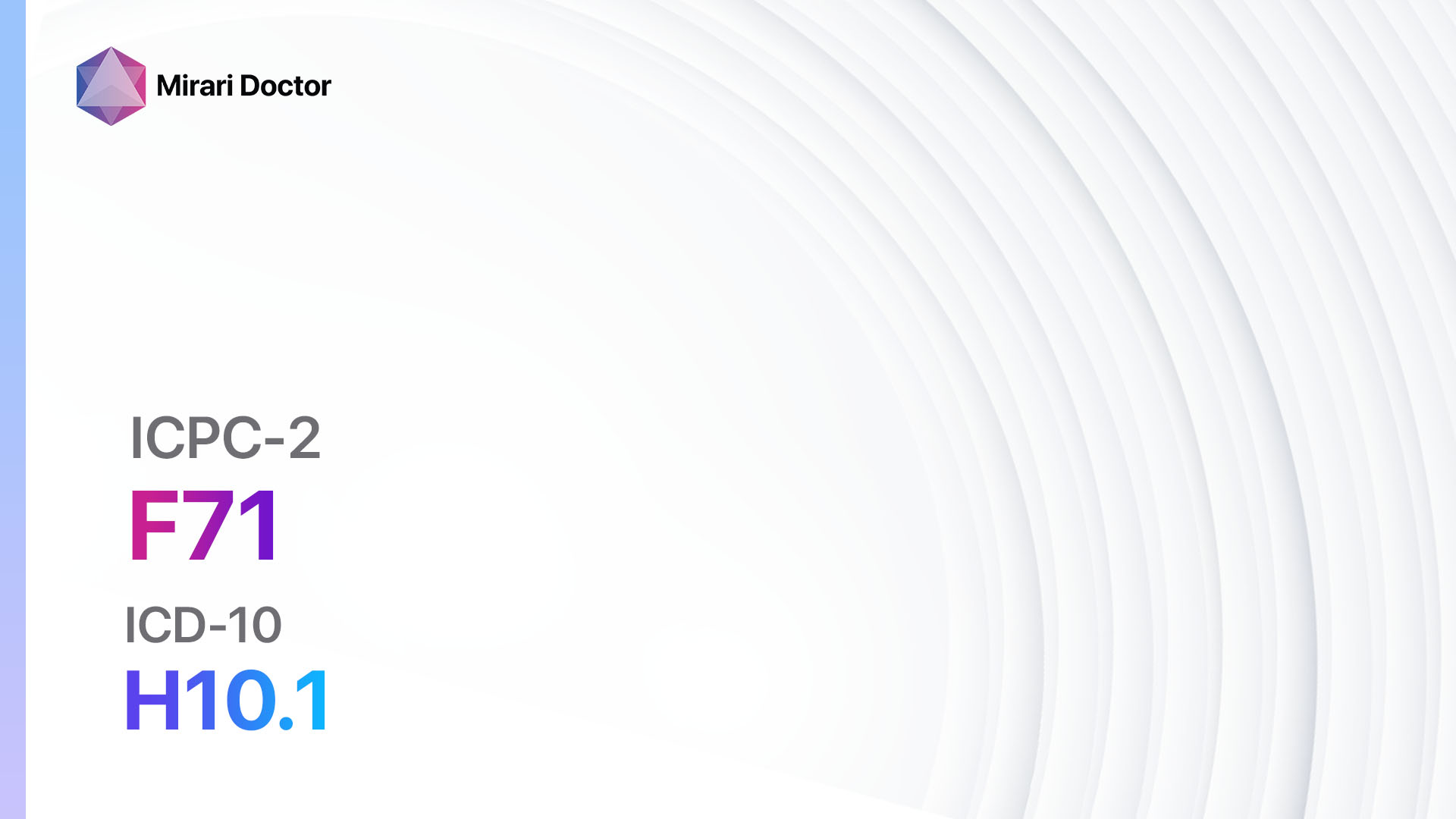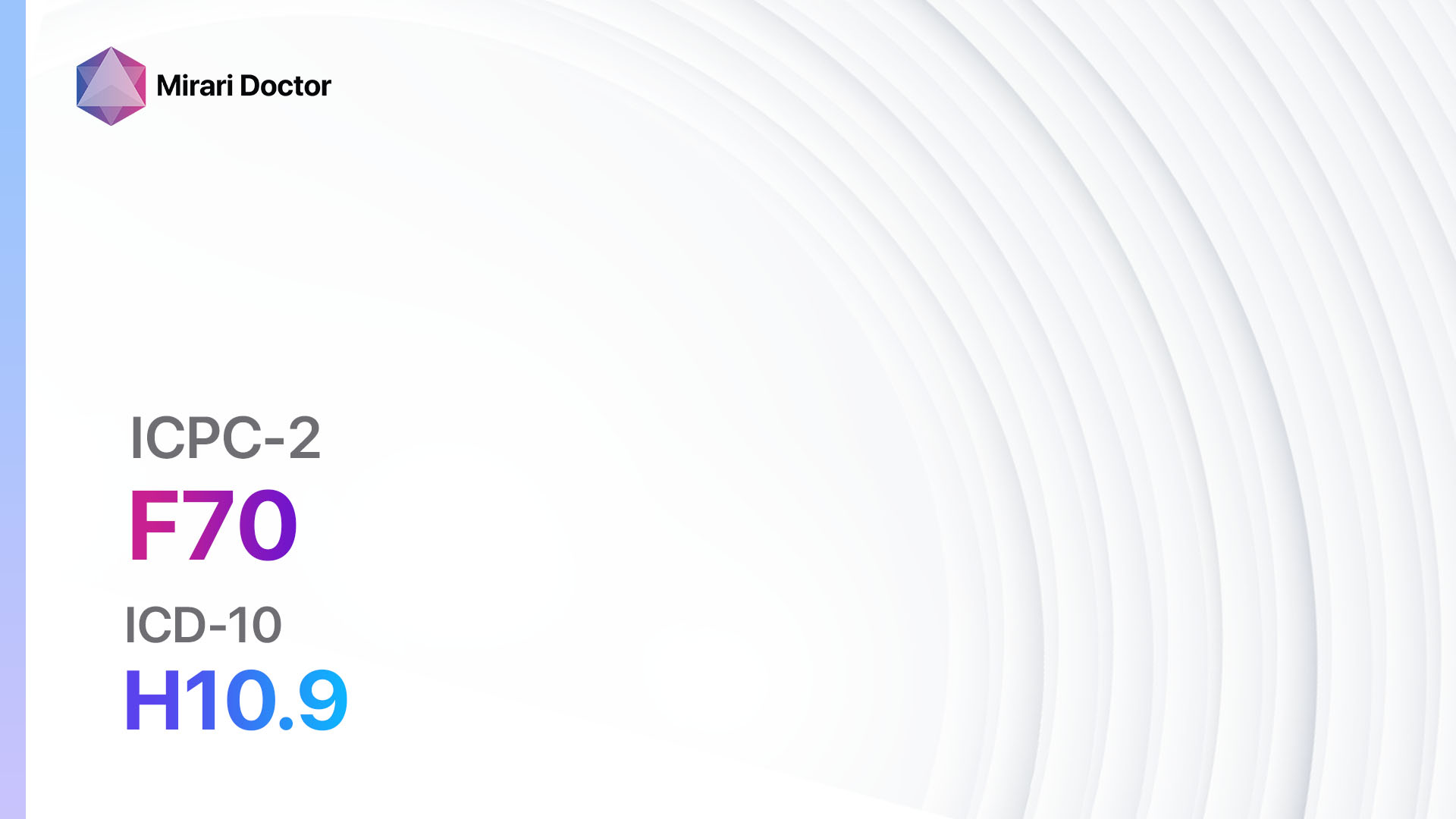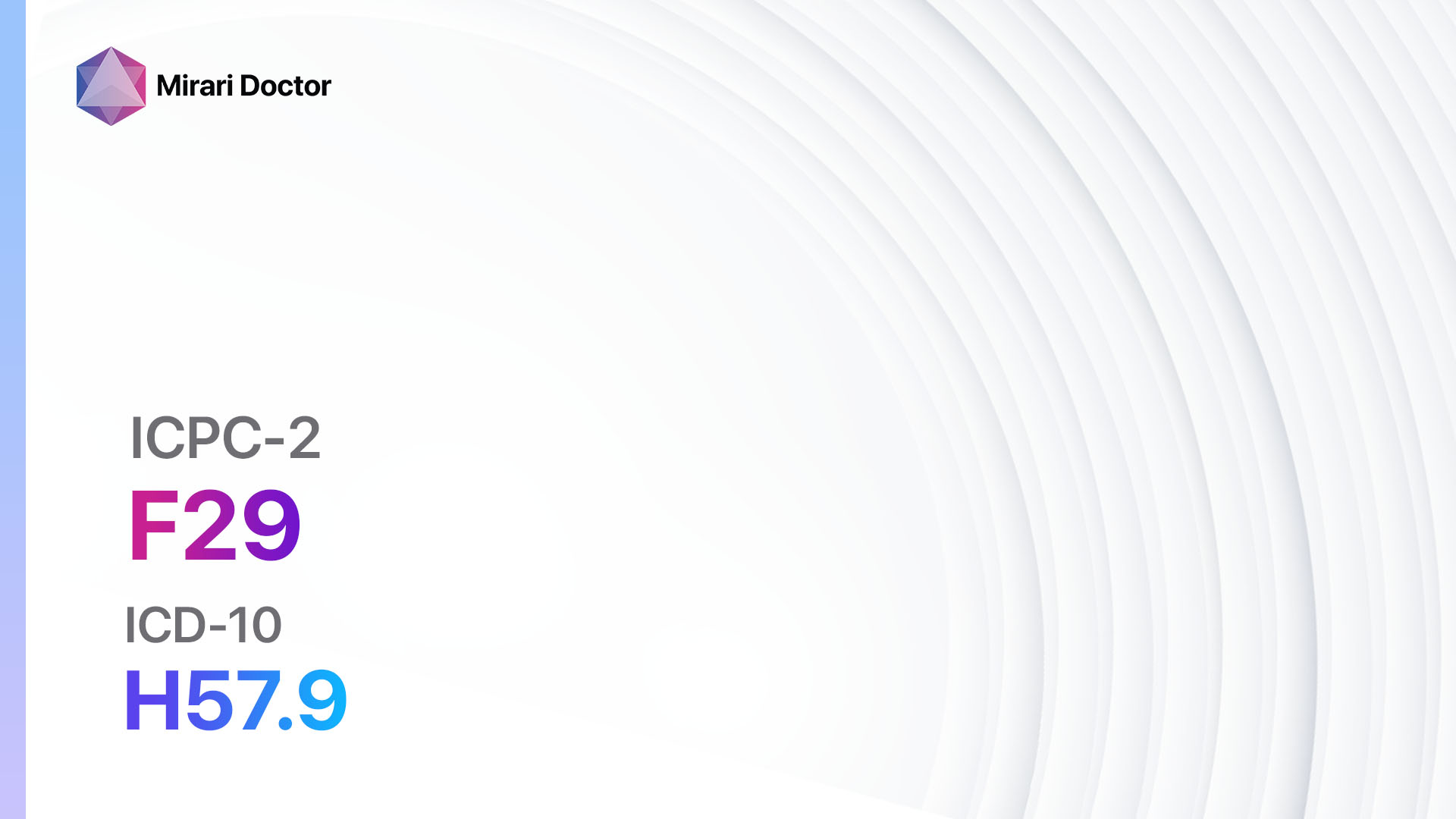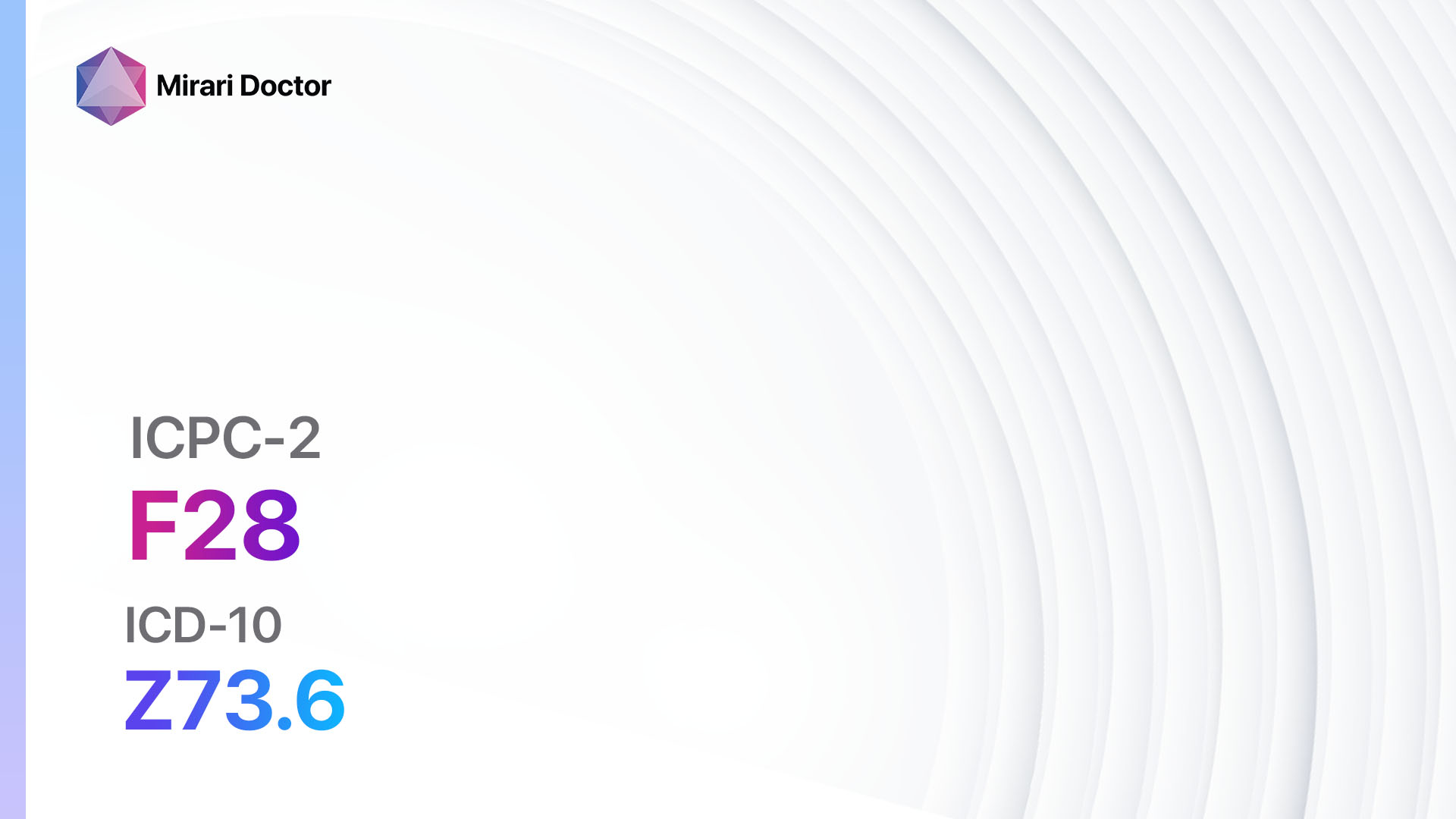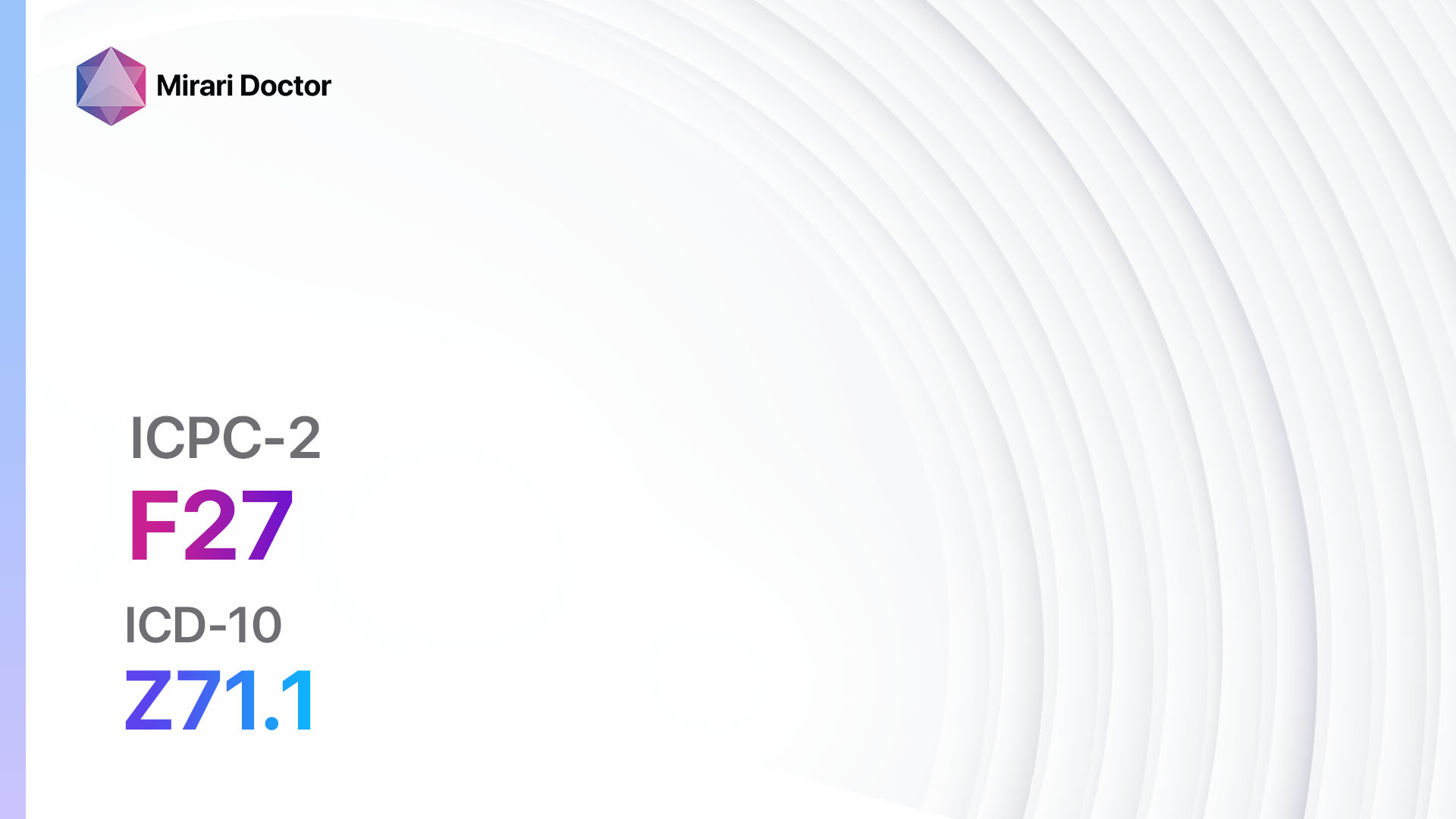
Introduction
Fear of eye disease (ICPC-2: F27) is a condition characterized by an excessive and irrational fear or anxiety related to the possibility of developing an eye disease. This fear can significantly impact a person’s daily life and may lead to avoidance of activities that could potentially harm the eyes or exacerbate existing eye conditions.[1][2] The aim of this guide is to provide healthcare professionals with a comprehensive approach to diagnosing and managing fear of eye disease.
Codes
- ICPC-2 Code: F27 Fear of eye disease[3]
- ICD-10 Code: Z71.1 Person with feared complaint in whom no diagnosis is made[4]
Symptoms
- Excessive worry or fear about developing an eye disease[5]
- Avoidance of activities that could potentially harm the eyes[6]
- Hypervigilance towards any changes or sensations in the eyes[7]
- Preoccupation with eye health and frequent checking of visual acuity[8]
- Physical symptoms of anxiety, such as increased heart rate, sweating, and trembling[9]
Causes
- Previous traumatic experience related to eye health or eye diseases[10]
- Family history of eye diseases
- Personal history of eye diseases or conditions
- Exposure to media or information that emphasizes the risks and consequences of eye diseases
- Generalized anxiety disorder or other anxiety disorders
Diagnostic Steps
Medical History
- Gather information about the patient’s personal and family history of eye diseases or conditions
- Assess any previous traumatic experiences related to eye health
- Inquire about the patient’s exposure to media or information about eye diseases
- Evaluate for symptoms of generalized anxiety disorder or other anxiety disorders
Physical Examination
- Perform a comprehensive eye examination to assess the patient’s current eye health
- Check visual acuity, intraocular pressure, and examine the external and internal structures of the eyes
- Look for any signs of existing eye diseases or conditions
- Assess for any physical manifestations of anxiety, such as increased heart rate or sweating
Laboratory Tests
- No specific laboratory tests are necessary for the diagnosis of fear of eye disease
- However, blood tests may be conducted to rule out any underlying medical conditions that could be contributing to the patient’s anxiety symptoms
Diagnostic Imaging
- Diagnostic imaging is not typically required for the diagnosis of fear of eye disease
- However, in cases where there are specific concerns or symptoms that warrant further investigation, imaging modalities such as optical coherence tomography (OCT) or magnetic resonance imaging (MRI) may be used to assess the structure and function of the eyes
Other Tests
- Referral to a mental health professional for a psychological assessment may be necessary to evaluate for generalized anxiety disorder or other anxiety disorders that may be contributing to the fear of eye disease
Follow-up and Patient Education
- Schedule regular follow-up appointments to monitor the patient’s progress and provide ongoing support
- Provide patient education materials about eye health, common eye diseases, and strategies for managing anxiety related to eye health
- Encourage the patient to engage in relaxation techniques, such as deep breathing exercises or mindfulness meditation, to help manage anxiety symptoms
Possible Interventions
Traditional Interventions
Medications:
Top 5 drugs for fear of eye disease:
- Selective serotonin reuptake inhibitors (SSRIs) (e.g., Fluoxetine, Sertraline):
- Cost: Generic versions can be $3-$50/month.
- Contraindications: Hypersensitivity to SSRIs, concurrent use of monoamine oxidase inhibitors (MAOIs).
- Side effects: Nausea, headache, insomnia.
- Severe side effects: Serotonin syndrome, suicidal thoughts.
- Drug interactions: MAOIs, other serotonergic medications.
- Warning: May take several weeks to achieve full therapeutic effect.
- Benzodiazepines (e.g., Alprazolam, Diazepam):
- Cost: Generic versions can be $4-$50/month.
- Contraindications: Severe respiratory insufficiency, narrow-angle glaucoma.
- Side effects: Drowsiness, dizziness, confusion.
- Severe side effects: Respiratory depression, dependence.
- Drug interactions: Alcohol, other central nervous system depressants.
- Warning: Risk of tolerance and dependence with long-term use.
- Beta-blockers (e.g., Propranolol, Atenolol):
- Cost: Generic versions can be $4-$30/month.
- Contraindications: Severe bradycardia, heart block.
- Side effects: Fatigue, dizziness, bradycardia.
- Severe side effects: Bronchospasm, heart failure.
- Drug interactions: Calcium channel blockers, insulin.
- Warning: Should not be abruptly stopped.
- Antidepressants (e.g., Amitriptyline, Venlafaxine):
- Cost: Generic versions can be $4-$50/month.
- Contraindications: Recent myocardial infarction, concurrent use of MAOIs.
- Side effects: Dry mouth, constipation, sedation.
- Severe side effects: Serotonin syndrome, suicidal thoughts.
- Drug interactions: MAOIs, other serotonergic medications.
- Warning: May take several weeks to achieve full therapeutic effect.
- Antipsychotics (e.g., Quetiapine, Risperidone):
- Cost: Generic versions can be $4-$50/month.
- Contraindications: Severe central nervous system depression, dementia-related psychosis.
- Side effects: Sedation, weight gain, extrapyramidal symptoms.
- Severe side effects: Neuroleptic malignant syndrome, tardive dyskinesia.
- Drug interactions: Other antipsychotics, medications that prolong the QT interval.
- Warning: Increased risk of mortality in elderly patients with dementia-related psychosis.
Alternative Drugs:
- Buspirone: An anxiolytic medication that does not cause sedation or dependence.
- Hydroxyzine: An antihistamine with anxiolytic properties.
- Pregabalin: An anticonvulsant medication used for generalized anxiety disorder.
- Gabapentin: An anticonvulsant medication that may help with anxiety symptoms.
- Mirtazapine: An antidepressant that can also help with anxiety.
Surgical Procedures:
- Surgical procedures are not indicated for the treatment of fear of eye disease.
Alternative Interventions
- Cognitive-behavioral therapy (CBT): A form of psychotherapy that helps individuals identify and change negative thought patterns and behaviors associated with fear of eye disease. Cost: $100-$200 per session.
- Eye relaxation exercises: Techniques such as palming, eye rolling, and eye massage can help alleviate eye strain and promote relaxation. Cost: Free.
- Mindfulness meditation: A practice that involves focusing attention on the present moment, which can help reduce anxiety and promote overall well-being. Cost: Free (self-guided) or $10-$30 per session (guided classes).
- Support groups: Joining a support group with individuals who have similar fears or anxieties about eye health can provide a sense of community and understanding. Cost: Free or minimal fees for group membership.
- Biofeedback therapy: A technique that uses electronic devices to measure and provide feedback on physiological responses, such as heart rate and muscle tension, to help individuals learn to control their anxiety symptoms. Cost: $50-$100 per session.
Lifestyle Interventions
- Regular exercise: Engaging in physical activity can help reduce anxiety and promote overall well-being. Cost: Varies (e.g., gym membership, home exercise equipment).
- Healthy diet: Consuming a balanced diet rich in fruits, vegetables, whole grains, and lean proteins can support overall eye health and reduce the risk of eye diseases. Cost: Varies depending on food choices.
- Adequate sleep: Getting enough sleep is essential for overall health and can help manage anxiety symptoms. Cost: Free.
- Stress management techniques: Practicing stress management techniques such as deep breathing, progressive muscle relaxation, and journaling can help reduce anxiety. Cost: Free.
- Limiting screen time: Excessive screen time can contribute to eye strain and exacerbate anxiety symptoms. Setting limits on screen time and taking regular breaks can help alleviate these issues. Cost: Free.
It is important to note that the cost ranges provided are approximate and may vary depending on the location and availability of the interventions.
Mirari Cold Plasma Alternative Intervention
Understanding Mirari Cold Plasma
- Safe and Non-Invasive Treatment: Mirari Cold Plasma is a safe and non-invasive treatment option for various skin conditions. It does not require incisions, minimizing the risk of scarring, bleeding, or tissue damage.
- Efficient Extraction of Foreign Bodies: Mirari Cold Plasma facilitates the removal of foreign bodies from the skin by degrading and dissociating organic matter, allowing easier access and extraction.
- Pain Reduction and Comfort: Mirari Cold Plasma has a local analgesic effect, providing pain relief during the treatment, making it more comfortable for the patient.
- Reduced Risk of Infection: Mirari Cold Plasma has antimicrobial properties, effectively killing bacteria and reducing the risk of infection.
- Accelerated Healing and Minimal Scarring: Mirari Cold Plasma stimulates wound healing and tissue regeneration, reducing healing time and minimizing the formation of scars.
Mirari Cold Plasma Prescription
Video instructions for using Mirari Cold Plasma Device – F27 Fear of eye disease (ICD-10:Z71.1)
| Mild | Moderate | Severe |
| Mode setting: 1 (Infection) Location: 7 (Neuro system & ENT) Morning: 15 minutes, Evening: 15 minutes |
Mode setting: 1 (Infection) Location: 7 (Neuro system & ENT) Morning: 30 minutes, Lunch: 30 minutes, Evening: 30 minutes |
Mode setting: 1 (Infection) Location: 7 (Neuro system & ENT) Morning: 30 minutes, Lunch: 30 minutes, Evening: 30 minutes |
| Mode setting: 2 (Wound Healing) Location: 7 (Neuro system & ENT) Morning: 15 minutes, Evening: 15 minutes |
Mode setting: 2 (Wound Healing) Location: 7 (Neuro system & ENT) Morning: 30 minutes, Lunch: 30 minutes, Evening: 30 minutes |
Mode setting: 2 (Wound Healing) Location: 7 (Neuro system & ENT) Morning: 30 minutes, Lunch: 30 minutes, Evening: 30 minutes |
| Mode setting: 3 (Antiviral Therapy) Location: 7 (Neuro system & ENT) Morning: 15 minutes, Evening: 15 minutes |
Mode setting: 3 (Antiviral Therapy) Location: 7 (Neuro system & ENT) Morning: 30 minutes, Lunch: 30 minutes, Evening: 30 minutes |
Mode setting: 3 (Antiviral Therapy) Location: 7 (Neuro system & ENT) Morning: 30 minutes, Lunch: 30 minutes, Evening: 30 minutes |
| Total Morning: 45 minutes approx. $7.50 USD, Evening: 45 minutes approx. $7.50 USD |
Total Morning: 90 minutes approx. $15 USD, Lunch: 90 minutes approx. $15 USD, Evening: 90 minutes approx. $15 USD, |
Total Morning: 90 minutes approx. $15 USD, Lunch: 90 minutes approx. $15 USD, Evening: 90 minutes approx. $15 USD, |
| Usual treatment for 7-60 days approx. $105 USD – $900 USD | Usual treatment for 6-8 weeks approx. $1,890 USD – $2,520 USD |
Usual treatment for 3-6 months approx. $4,050 USD – $8,100 USD
|
 |
|
Use the Mirari Cold Plasma device to treat Fear of eye disease effectively.
WARNING: MIRARI COLD PLASMA IS DESIGNED FOR THE HUMAN BODY WITHOUT ANY ARTIFICIAL OR THIRD PARTY PRODUCTS. USE OF OTHER PRODUCTS IN COMBINATION WITH MIRARI COLD PLASMA MAY CAUSE UNPREDICTABLE EFFECTS, HARM OR INJURY. PLEASE CONSULT A MEDICAL PROFESSIONAL BEFORE COMBINING ANY OTHER PRODUCTS WITH USE OF MIRARI.
Step 1: Cleanse the Skin
- Start by cleaning the affected area of the skin with a gentle cleanser or mild soap and water. Gently pat the area dry with a clean towel.
Step 2: Prepare the Mirari Cold Plasma device
- Ensure that the Mirari Cold Plasma device is fully charged or has fresh batteries as per the manufacturer’s instructions. Make sure the device is clean and in good working condition.
- Switch on the Mirari device using the power button or by following the specific instructions provided with the device.
- Some Mirari devices may have adjustable settings for intensity or treatment duration. Follow the manufacturer’s instructions to select the appropriate settings based on your needs and the recommended guidelines.
Step 3: Apply the Device
- Place the Mirari device in direct contact with the affected area of the skin. Gently glide or hold the device over the skin surface, ensuring even coverage of the area experiencing.
- Slowly move the Mirari device in a circular motion or follow a specific pattern as indicated in the user manual. This helps ensure thorough treatment coverage.
Step 4: Monitor and Assess:
- Keep track of your progress and evaluate the effectiveness of the Mirari device in managing your Fear of eye disease. If you have any concerns or notice any adverse reactions, consult with your health care professional.
Note
This guide is for informational purposes only and should not replace the advice of a medical professional. Always consult with your healthcare provider or a qualified medical professional for personal advice, diagnosis, or treatment. Do not solely rely on the information presented here for decisions about your health. Use of this information is at your own risk. The authors of this guide, nor any associated entities or platforms, are not responsible for any potential adverse effects or outcomes based on the content.
Mirari Cold Plasma System Disclaimer
- Purpose: The Mirari Cold Plasma System is a Class 2 medical device designed for use by trained healthcare professionals. It is registered for use in Thailand and Vietnam. It is not intended for use outside of these locations.
- Informational Use: The content and information provided with the device are for educational and informational purposes only. They are not a substitute for professional medical advice or care.
- Variable Outcomes: While the device is approved for specific uses, individual outcomes can differ. We do not assert or guarantee specific medical outcomes.
- Consultation: Prior to utilizing the device or making decisions based on its content, it is essential to consult with a Certified Mirari Tele-Therapist and your medical healthcare provider regarding specific protocols.
- Liability: By using this device, users are acknowledging and accepting all potential risks. Neither the manufacturer nor the distributor will be held accountable for any adverse reactions, injuries, or damages stemming from its use.
- Geographical Availability: This device has received approval for designated purposes by the Thai and Vietnam FDA. As of now, outside of Thailand and Vietnam, the Mirari Cold Plasma System is not available for purchase or use.
References
-
- Schneier, F. R., Rodebaugh, T. L., Blanco, C., Lewin, H., & Liebowitz, M. R. (2011). Fear and avoidance of eye contact in social anxiety disorder. Comprehensive Psychiatry, 52(1), 81-87. https://doi.org/10.1016/j.comppsych.2010.04.006
- Chaya, K., Xue, Y., Uto, Y., Yao, Q., & Yamada, Y. (2016). Fear of eyes: triadic relation among social anxiety, trypophobia, and discomfort for eye cluster. PeerJ, 4, e2349. https://doi.org/10.7717/peerj.2349
- World Organization of Family Doctors (WONCA). (2005). ICPC-2-R: International Classification of Primary Care (2nd ed., revised). Oxford University Press.
- Centers for Medicare & Medicaid Services. (2018). ICD-10-CM Official Guidelines for Coding and Reporting. https://www.cdc.gov/nchs/data/icd/10cmguidelines-FY2018-final.pdf
- Stein, M. B., & Stein, D. J. (2008). Social anxiety disorder. The Lancet, 371(9618), 1115-1125. https://doi.org/10.1016/S0140-6736(08)60488-2
- Chaya, K., Xue, Y., Uto, Y., Yao, Q., & Yamada, Y. (2016). Fear of eyes: triadic relation among social anxiety, trypophobia, and discomfort for eye cluster. PeerJ, 4, e2349. https://doi.org/10.7717/peerj.2349
- Nita, Małgorzata ; Strzałka-Mrozik, Barbara ; Grzybowski, Andrzej ; Mazurek, Urszula ; Romaniuk, Wanda (2014.0). Age-related macular degeneration and changes in the extracellular matrix. DOI: 10.12659/MSM.889887
- Aslan, Mutay ; Cort, Aysegul ; Yucel, Iclal (2008.0). Oxidative and nitrative stress markers in glaucoma. DOI: 10.1016/j.freeradbiomed.2008.04.026
- American Psychiatric Association. (2013). Diagnostic and statistical manual of mental disorders (5th ed.). https://doi.org/10.1176/appi.books.9780890425596
- Takusewanya, M. (2019). How to take a complete eye history. Community Eye Health, 32(107), 44-45. https://www.ncbi.nlm.nih.gov/pmc/articles/PMC6277212/
Related articles
Made in USA


